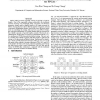Free Online Productivity Tools
i2Speak
i2Symbol
i2OCR
iTex2Img
iWeb2Print
iWeb2Shot
i2Type
iPdf2Split
iPdf2Merge
i2Bopomofo
i2Arabic
i2Style
i2Image
i2PDF
iLatex2Rtf
Sci2ools
130
click to vote
DAC
2000
ACM
2000
ACM
An architecture-driven metric for simultaneous placement and global routing for FPGAs
FPGA routing resources typically consist of segments of various lengths. Due to the segmented routing architectures, the traditional measure of wiring cost (wirelength, delay, congestion, etc) based on geometric distance and/or channel density is no longer accurate for FPGAs. Researchers have shown that the number of segments, instead of geometric (Manhattan) distance, traveled by a net is the most crucial factor in controlling the routing delay and cost in an FPGA. Further, the congestion information of a routing channel shall be measured by the available segments of specific lengths, instead of the density in a channel alone. In this paper, we propose an architecture-driven metric for simultaneous FPGA placement and global routing. The new metric considers the available segments and their lengths to optimize the wiring cost for placement and global routing. Experiments by employing a cluster growth placement and maze routing to demonstrate the new metric show respective average redu...
| Added | 13 Nov 2009 |
| Updated | 13 Nov 2009 |
| Type | Conference |
| Year | 2000 |
| Where | DAC |
| Authors | Yao-Wen Chang, Yu-Tsang Chang |
Comments (0)

